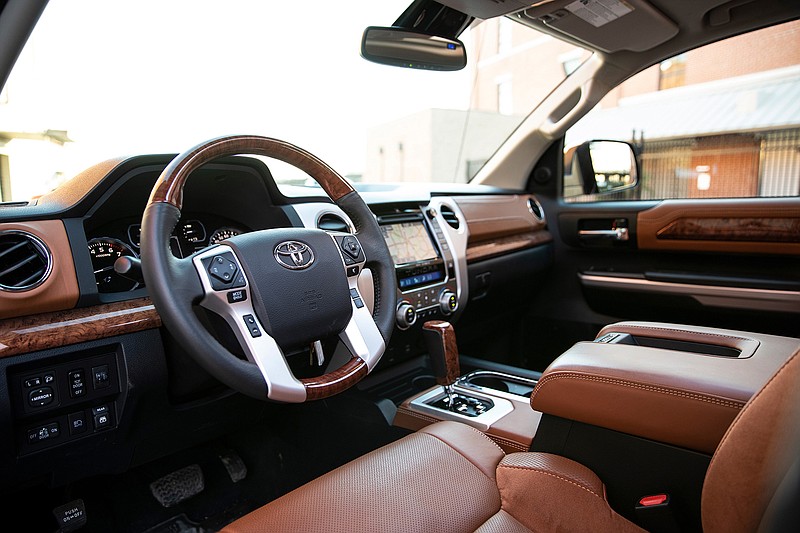The Toyota Tundra 1794 edition pays homage to the once oldest working ranch in Texas, the JLC Ranch; a 209-year-old, 24,000-acre plot of land that Toyota acquired in 2003.
For 2019, Toyota is celebrating 15 years since breaking ground at the plant. The first full-size Tundra models rolled off the assembly line in 2008. The mid-size Tacoma followed suit in 2011.
Since then, all Tundra and Tacoma pickups have been built in San Antonio. That's a point of pride for Toyota dealers in Texas, as every pickup sold wears a sticker on the back window patterned after the state flag that says "Built Here, Lives Here." It's the same type of homage that Dallas-built Fords once had: "Built in Texas by Texans".
So here we are at the end of 2019 production, and the beginning of 2020. Over the past decade, the Tundra hasn't changed all that much, with the exception of a significant 2014 update. That was the same year Toyota introduced the 1794 Edition, and not a lot has changed, year-to-year, on that model as well.
A clean-sheet Tundra is in the works, but the old model continues to sell well. Despite terrible fuel-economy ratings, Tundra's high reliability and safety scores have kept it in the market. continues to be a good buy. The 2019 model was ranked as Edmunds Best Retained Value winner for Large Trucks, as well as a 2019 Five-Year Cost to Own Award from Kelley Blue Book's KBB.com as well as KBB Top 10 for Best Resale Value.
Think of the 1794 Edition as Toyota's answer to Ford's luxo-truck, F-150 King Ranch. Our tester came in at $57,222. That's less than other western-themed competition, which includes the F-150 King Ranch, Ram 1500 Laramie Longhorn, and Chevrolet 1500 High Country.
If an ocean of brown leather is the look you're going for, you'll pay slightly less for it with Toyota's version. It has all the expected amenities, such as supple leather appointments and an optional power glass sunroof. But that's where the Tundra's edge stops.
While most buyers may not give a hang about panoramic power sunroofs, Ford started the trend beginning with the 2015 model and Ram followed suit for its redesigned 2019 model. Even Nissan got the memo, offering an oversized roof for its restyled 2020 Titan. Previously, it didn't offer any hole in the roof for its XD model.
But the biggest faux pas was that our 1794 Edition loaner was missing the retractable running boards that even my friend has on his TRD Pro. That's a serious miss since our tester was the higher stance 4x4 model. Granted, it's available as a $345 option, but even Ford includes them as standard on its F-150 King Ranch, Platinum, and Limited.
Using a step ladder to enter one's pickup is considered bourgeoise even in Texas, one of the most bourgeoise states in the nation. At least in the cities.
Another faux pas was that driving on a still summer-like Texas October day, the ladies in the rear seats couldn't coax enough cold air out of the two tiny vents to ward off a sweat. I can't even imagine what that would have been like in July, which ran all the way to July 77 this year.
There's no doubt that the 1794 Edition is the most Texan of all Tundra models. Our tester was a CrewMax model with a 5.5-foot bed and came powered by Toyota's 5.7-liter Entune V-8, which produces 381-hp and 401 lb.-ft of torque. It's mated to a six-speed automatic transmission which is quick to kick down a gear when trying to pass on the highway.
The drivetrain also had no trouble climbing steep grades but was a little sluggish until applying a little more acceleration. Other trucks offer myriad powertrain options for their full-size offerings; from turbo-fours to diesel-powered sixes to burly V8s, there are lots of options for buyers.
That being said, fuel economy does suffer substantially. The Tundra has EPA-estimated fuel economy ratings of 13 miles per gallon city, 17 mpg highway and 14 mpg combined with four-wheel drive. That falls woefully behind the F-150, Ram 1500 and GM twins, even with their largest V8 engine options.
The Tundra is decidedly dated. The 1794 Edition now comes equipped with keyless entry and push-button start, as well as remote start, which is a lifesaver in the Texas heat. Though the Tundra was heavily updated in 2014, the interior feels somewhat dated. The steering wheel is chunky, and controls appear to be a generation behind the times. The touchscreen infotainment system - although perfectly functional - lacks the sharp resolution and fast response customers have come to expect from newer vehicles.
The Tundra 4x4 1794 CrewMax offers 10.4 inches of ground clearance. I didn't have a chance to tow or haul anything during my week with the truck, but the 4x4 version has a max towing capacity of 8,800 pounds and a max payload of 1,530 pounds.
Living with the Tundra day wouldn't be difficult for drivers of larger stature, like myself, but for my petite wife that's a different story. I already mentioned the omission of retractable running boards. Plus, the driver's side doesn't have a grab handle on the A-pillar or above the window frame, so you end up pulling yourself up on the steering wheel or the generously sized door armrest.
As flip-up rear seats come, the Tundra 1794 Edition's benches are fairly comfy and supportive. The leather is soft, and there's plenty of cushioning for longer drives. There's also more than enough legroom.
The Tundra still checks most of the right boxes for today's truck buyer, but competitors are continually raising the bar in the full-size pickup category. If the next-gen Tundra can deliver class-leading fuel economy, modern tech, and improved material quality in addition to the comfort, capability, and durability today's Tundra already offers, then we Texans will have something to be proud of.

